In spite of Indiana weather--a solid week of rain followed
by miserable heat--we expanded several units, have a lot of interesting
artifacts, and have hosted a bunch of visitors and learned a lot from them.
With less than a week left in the field school's excavation time, here's some of
what we've done over the last couple weeks.
 Pam
Peterson's class from Greenfield Elementary School joined us to dig on
June 2nd. It wasn't typical summer digging weather: cold, rainy, and
windy, which is why they've all got their arms crammed into their shirts
conserving body heat (click on the thumbnailed picture to see it in a
larger size). Pam
Peterson's class from Greenfield Elementary School joined us to dig on
June 2nd. It wasn't typical summer digging weather: cold, rainy, and
windy, which is why they've all got their arms crammed into their shirts
conserving body heat (click on the thumbnailed picture to see it in a
larger size). |
 Since
it was so chilly, the class was really pretty happy to dig. Here
they're revealing the foundations of the Evans Boarding House with help
from Jody Hester and Tim Alldredge. Since
it was so chilly, the class was really pretty happy to dig. Here
they're revealing the foundations of the Evans Boarding House with help
from Jody Hester and Tim Alldredge. |
 This
10-foot by 3 foot trench (thumbnail right) was placed within the Deschler shop and revealed
the laid brick surface on the left of this picture and the adjoining
concrete flooring. Insurance maps show an engine in this part of the
meat packing shop. This thumbnail near right is what the unit looked
like on June 9. A dense deposit of circa 1920-1935 artifacts was
recovered beneath this surface, including the medicine bottle Bridget
Parkerson is holding (far right). This
10-foot by 3 foot trench (thumbnail right) was placed within the Deschler shop and revealed
the laid brick surface on the left of this picture and the adjoining
concrete flooring. Insurance maps show an engine in this part of the
meat packing shop. This thumbnail near right is what the unit looked
like on June 9. A dense deposit of circa 1920-1935 artifacts was
recovered beneath this surface, including the medicine bottle Bridget
Parkerson is holding (far right). |
 |
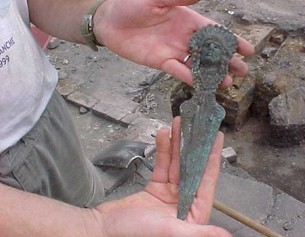
|
This letter opener
(left) was among the artifacts found in the packing shop's engine room.
The Imperial Mange Medicine bottle (right)
came from this same fill that likely was deposited around the time the
shop buildings were destroyed. |
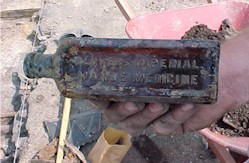 |
 This
small silver spoon probably was not being used in the Deschler shop, and
in fact much of the assemblage associated with the Deschlers is typical
household trash. There are some specialized objects that were
probably from equipment in the shop, but a fair volume of what we've found
looks like their trash and discards from the African-American households
that lived at the home after the Deschlers left. This
small silver spoon probably was not being used in the Deschler shop, and
in fact much of the assemblage associated with the Deschlers is typical
household trash. There are some specialized objects that were
probably from equipment in the shop, but a fair volume of what we've found
looks like their trash and discards from the African-American households
that lived at the home after the Deschlers left. |
 This
now-solidified chunk is composed of thousands of tiny springs (click on
thumbnail for larger picture). Very dense deposits including
thousands of these springs were recovered from the shop: we assume
they're from some equipment used in the shop, but we don't know what. This
now-solidified chunk is composed of thousands of tiny springs (click on
thumbnail for larger picture). Very dense deposits including
thousands of these springs were recovered from the shop: we assume
they're from some equipment used in the shop, but we don't know what. |
 Visitors
from the Horizons Program at St. Richard's School peer into the unit
Carrie Kissel is digging along the north wall of the meat packing shop
while Ken Spencer tells them about the unit. Visitors
from the Horizons Program at St. Richard's School peer into the unit
Carrie Kissel is digging along the north wall of the meat packing shop
while Ken Spencer tells them about the unit. The thumbnail right shows the wall June 13th, when it was already 15
courses deep. This foundation certainly was much more substantial
than we anticipated, since most outbuildings are frame or have modest
brick foundations, but the Deschlers built a quite solid structure.
The thumbnail right shows the wall June 13th, when it was already 15
courses deep. This foundation certainly was much more substantial
than we anticipated, since most outbuildings are frame or have modest
brick foundations, but the Deschlers built a quite solid structure. |
| In the Evans Boarding House we've opened
a new unit and a trench. Jody Hester and Nicole Shelton are here in
the foreground excavating that unit (and tolerating their 15 minutes of
fame while they get filmed by local TV). Lyn Coles and Ken Spencer
are in the background giving a tour and digging with children from
Freetown Village's Summer Camp, who joined us June 15th.
Below left Quentin Lewis shows off a unit to
Freetown campers. |
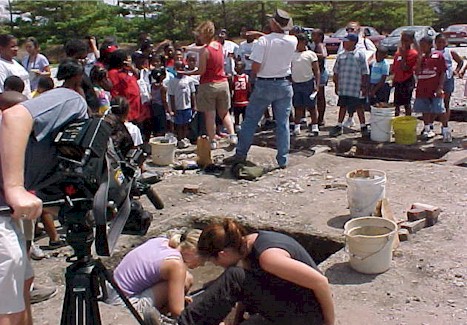 |
 |
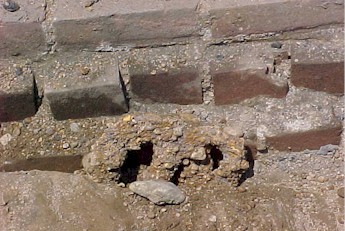 The
unit that Quentin is pointing toward contains a "builder's
trench" along the west wall, a space where the builders dug down to
place the foundation. Though they didn't leave many artifacts in the
trench, they did leave two horseshoes that are corroded together at the
center of this picture on the right. The
unit that Quentin is pointing toward contains a "builder's
trench" along the west wall, a space where the builders dug down to
place the foundation. Though they didn't leave many artifacts in the
trench, they did leave two horseshoes that are corroded together at the
center of this picture on the right. |
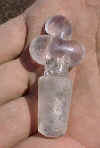 |
This glass bottle stopper
(thumbnail left) was recovered from a unit within the Evans boarding
house. The boarding house's west end did not contain many artifacts,
but the eastern end has had a denser quantity of objects, including this
inkwell (thumbnail right). |
 |
 Page,
Kaela, and Adam Clemens (right) are screening soil from the Boarding
House, which lay in the rear of this picture where Jody and Nicole are
shoveling. Page,
Kaela, and Adam Clemens (right) are screening soil from the Boarding
House, which lay in the rear of this picture where Jody and Nicole are
shoveling. |
 Here
Ken Spencer shows a freshly excavated pig skull to Adam Clemens.
Since there isn't much skeletal material on site, it appears that most
bones like this were discarded away from the site rather than on it. Here
Ken Spencer shows a freshly excavated pig skull to Adam Clemens.
Since there isn't much skeletal material on site, it appears that most
bones like this were discarded away from the site rather than on it. |
Field excavations will soon end, but in the coming weeks
we'll begin to process artifacts and prepare a report on the site's
excavation. In the meantime, check back soon for a brief end of summer
report.
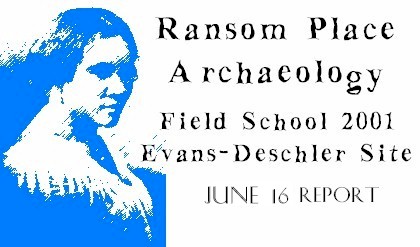
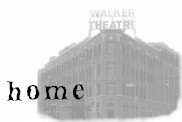






 The
unit that Quentin is pointing toward contains a "builder's
trench" along the west wall, a space where the builders dug down to
place the foundation. Though they didn't leave many artifacts in the
trench, they did leave two horseshoes that are corroded together at the
center of this picture on the right.
The
unit that Quentin is pointing toward contains a "builder's
trench" along the west wall, a space where the builders dug down to
place the foundation. Though they didn't leave many artifacts in the
trench, they did leave two horseshoes that are corroded together at the
center of this picture on the right. Page,
Kaela, and Adam Clemens (right) are screening soil from the Boarding
House, which lay in the rear of this picture where Jody and Nicole are
shoveling.
Page,
Kaela, and Adam Clemens (right) are screening soil from the Boarding
House, which lay in the rear of this picture where Jody and Nicole are
shoveling. Here
Ken Spencer shows a freshly excavated pig skull to Adam Clemens.
Since there isn't much skeletal material on site, it appears that most
bones like this were discarded away from the site rather than on it.
Here
Ken Spencer shows a freshly excavated pig skull to Adam Clemens.
Since there isn't much skeletal material on site, it appears that most
bones like this were discarded away from the site rather than on it.